Apple Policies: Dividend and Pay-out Policy Analysis
VerifiedAdded on 2023/05/28
|13
|2823
|435
AI Summary
This report analyzes Apple's dividend and pay-out policy, including cash dividends and share buybacks. It discusses the challenges faced by Apple and provides recommendations for investors. The report also includes a DCF model to determine the intrinsic value of Apple's shares.
Contribute Materials
Your contribution can guide someone’s learning journey. Share your
documents today.
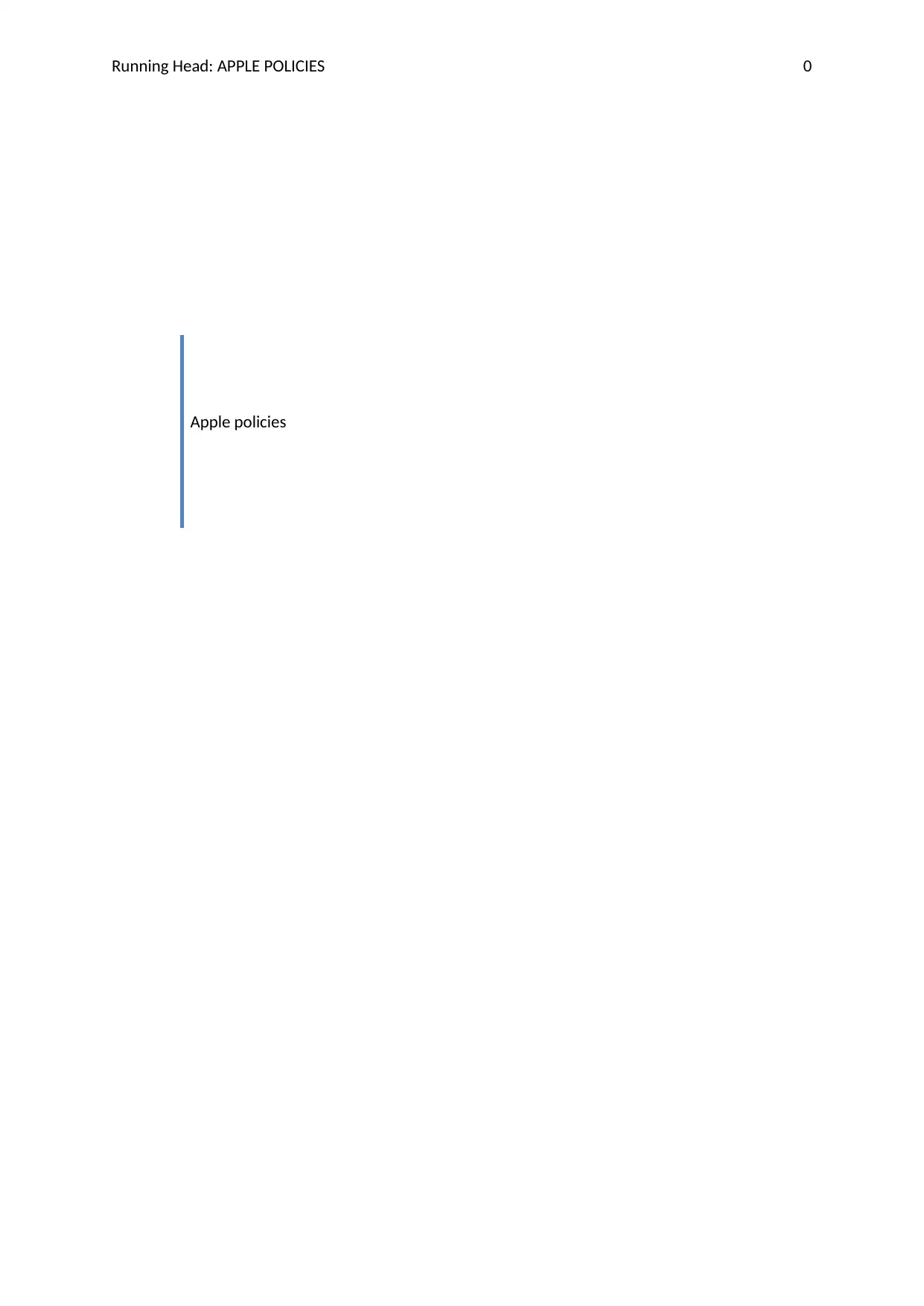
Running Head: APPLE POLICIES 0
Apple policies
Apple policies
Secure Best Marks with AI Grader
Need help grading? Try our AI Grader for instant feedback on your assignments.
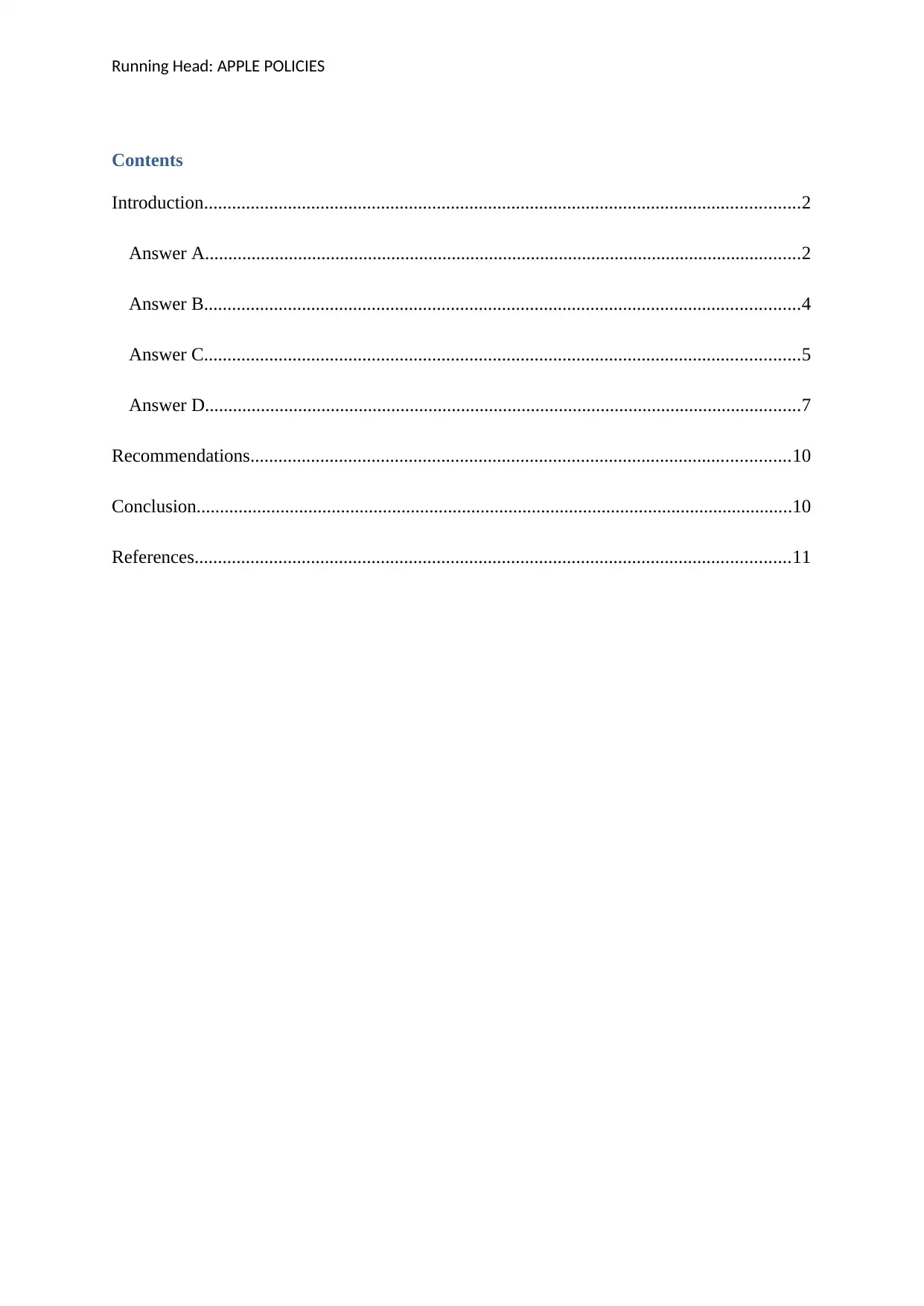
Running Head: APPLE POLICIES
Contents
Introduction................................................................................................................................2
Answer A................................................................................................................................2
Answer B................................................................................................................................4
Answer C................................................................................................................................5
Answer D................................................................................................................................7
Recommendations....................................................................................................................10
Conclusion................................................................................................................................10
References................................................................................................................................11
Contents
Introduction................................................................................................................................2
Answer A................................................................................................................................2
Answer B................................................................................................................................4
Answer C................................................................................................................................5
Answer D................................................................................................................................7
Recommendations....................................................................................................................10
Conclusion................................................................................................................................10
References................................................................................................................................11
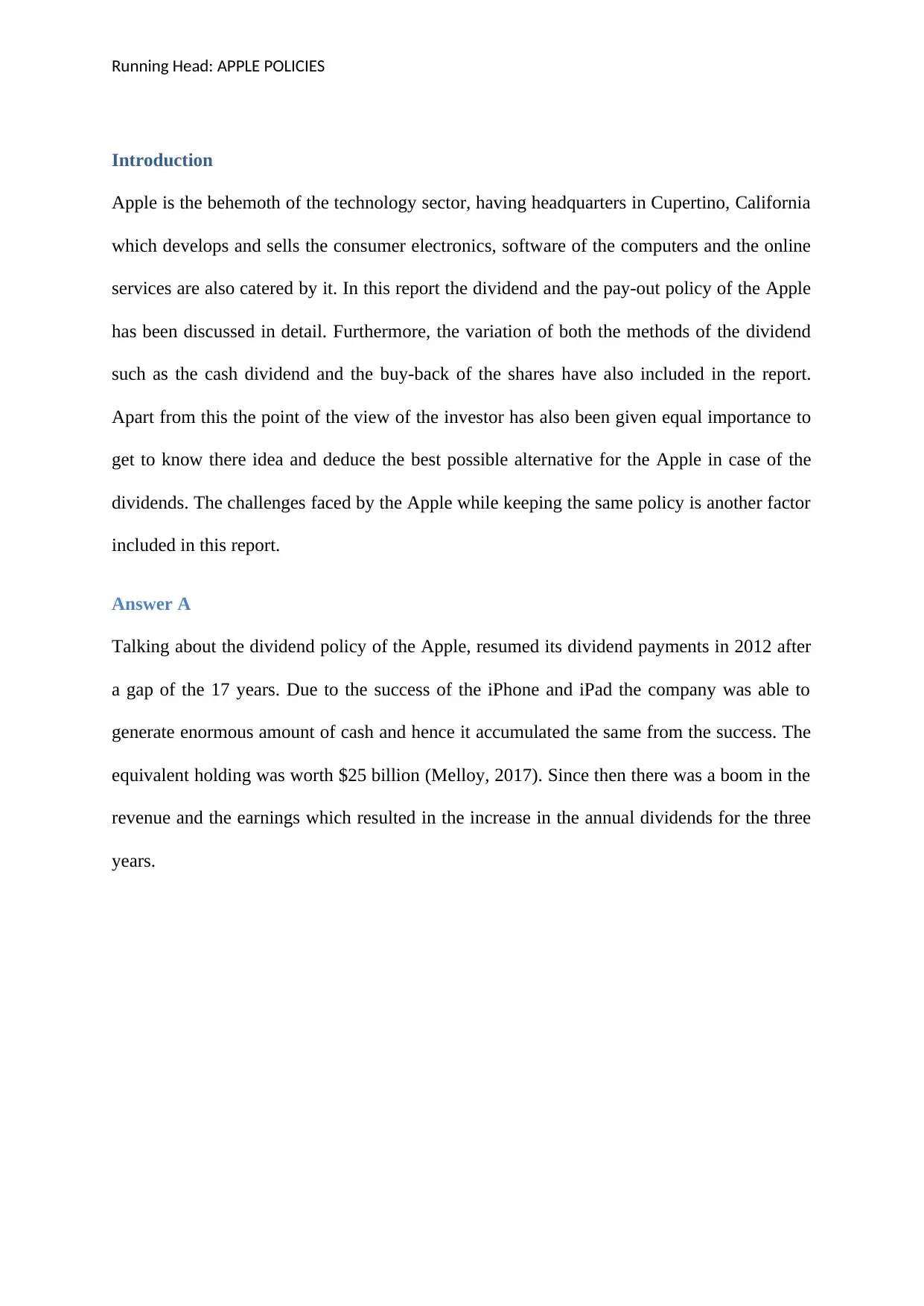
Running Head: APPLE POLICIES
Introduction
Apple is the behemoth of the technology sector, having headquarters in Cupertino, California
which develops and sells the consumer electronics, software of the computers and the online
services are also catered by it. In this report the dividend and the pay-out policy of the Apple
has been discussed in detail. Furthermore, the variation of both the methods of the dividend
such as the cash dividend and the buy-back of the shares have also included in the report.
Apart from this the point of the view of the investor has also been given equal importance to
get to know there idea and deduce the best possible alternative for the Apple in case of the
dividends. The challenges faced by the Apple while keeping the same policy is another factor
included in this report.
Answer A
Talking about the dividend policy of the Apple, resumed its dividend payments in 2012 after
a gap of the 17 years. Due to the success of the iPhone and iPad the company was able to
generate enormous amount of cash and hence it accumulated the same from the success. The
equivalent holding was worth $25 billion (Melloy, 2017). Since then there was a boom in the
revenue and the earnings which resulted in the increase in the annual dividends for the three
years.
Introduction
Apple is the behemoth of the technology sector, having headquarters in Cupertino, California
which develops and sells the consumer electronics, software of the computers and the online
services are also catered by it. In this report the dividend and the pay-out policy of the Apple
has been discussed in detail. Furthermore, the variation of both the methods of the dividend
such as the cash dividend and the buy-back of the shares have also included in the report.
Apart from this the point of the view of the investor has also been given equal importance to
get to know there idea and deduce the best possible alternative for the Apple in case of the
dividends. The challenges faced by the Apple while keeping the same policy is another factor
included in this report.
Answer A
Talking about the dividend policy of the Apple, resumed its dividend payments in 2012 after
a gap of the 17 years. Due to the success of the iPhone and iPad the company was able to
generate enormous amount of cash and hence it accumulated the same from the success. The
equivalent holding was worth $25 billion (Melloy, 2017). Since then there was a boom in the
revenue and the earnings which resulted in the increase in the annual dividends for the three
years.
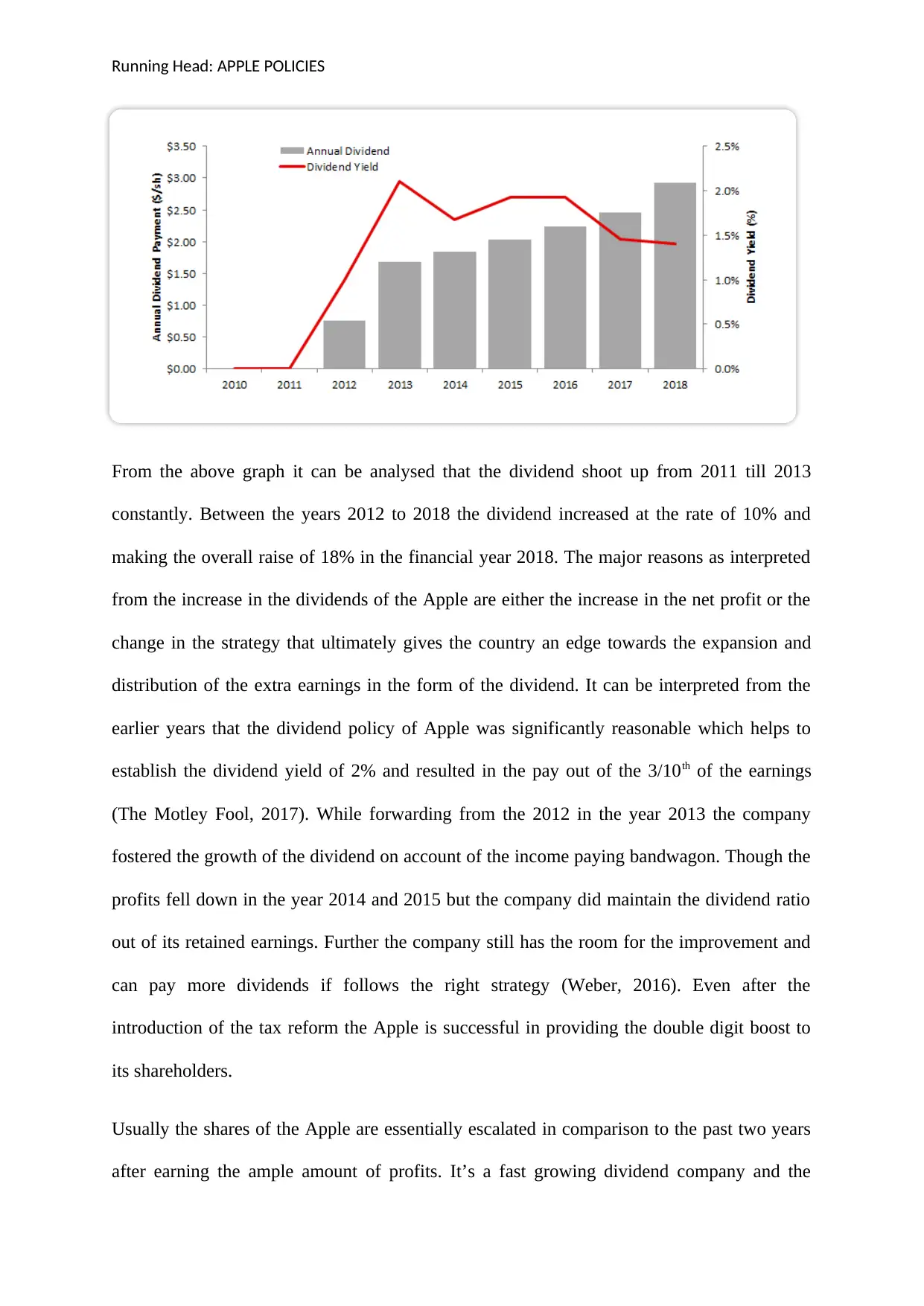
Running Head: APPLE POLICIES
From the above graph it can be analysed that the dividend shoot up from 2011 till 2013
constantly. Between the years 2012 to 2018 the dividend increased at the rate of 10% and
making the overall raise of 18% in the financial year 2018. The major reasons as interpreted
from the increase in the dividends of the Apple are either the increase in the net profit or the
change in the strategy that ultimately gives the country an edge towards the expansion and
distribution of the extra earnings in the form of the dividend. It can be interpreted from the
earlier years that the dividend policy of Apple was significantly reasonable which helps to
establish the dividend yield of 2% and resulted in the pay out of the 3/10th of the earnings
(The Motley Fool, 2017). While forwarding from the 2012 in the year 2013 the company
fostered the growth of the dividend on account of the income paying bandwagon. Though the
profits fell down in the year 2014 and 2015 but the company did maintain the dividend ratio
out of its retained earnings. Further the company still has the room for the improvement and
can pay more dividends if follows the right strategy (Weber, 2016). Even after the
introduction of the tax reform the Apple is successful in providing the double digit boost to
its shareholders.
Usually the shares of the Apple are essentially escalated in comparison to the past two years
after earning the ample amount of profits. It’s a fast growing dividend company and the
From the above graph it can be analysed that the dividend shoot up from 2011 till 2013
constantly. Between the years 2012 to 2018 the dividend increased at the rate of 10% and
making the overall raise of 18% in the financial year 2018. The major reasons as interpreted
from the increase in the dividends of the Apple are either the increase in the net profit or the
change in the strategy that ultimately gives the country an edge towards the expansion and
distribution of the extra earnings in the form of the dividend. It can be interpreted from the
earlier years that the dividend policy of Apple was significantly reasonable which helps to
establish the dividend yield of 2% and resulted in the pay out of the 3/10th of the earnings
(The Motley Fool, 2017). While forwarding from the 2012 in the year 2013 the company
fostered the growth of the dividend on account of the income paying bandwagon. Though the
profits fell down in the year 2014 and 2015 but the company did maintain the dividend ratio
out of its retained earnings. Further the company still has the room for the improvement and
can pay more dividends if follows the right strategy (Weber, 2016). Even after the
introduction of the tax reform the Apple is successful in providing the double digit boost to
its shareholders.
Usually the shares of the Apple are essentially escalated in comparison to the past two years
after earning the ample amount of profits. It’s a fast growing dividend company and the
Secure Best Marks with AI Grader
Need help grading? Try our AI Grader for instant feedback on your assignments.
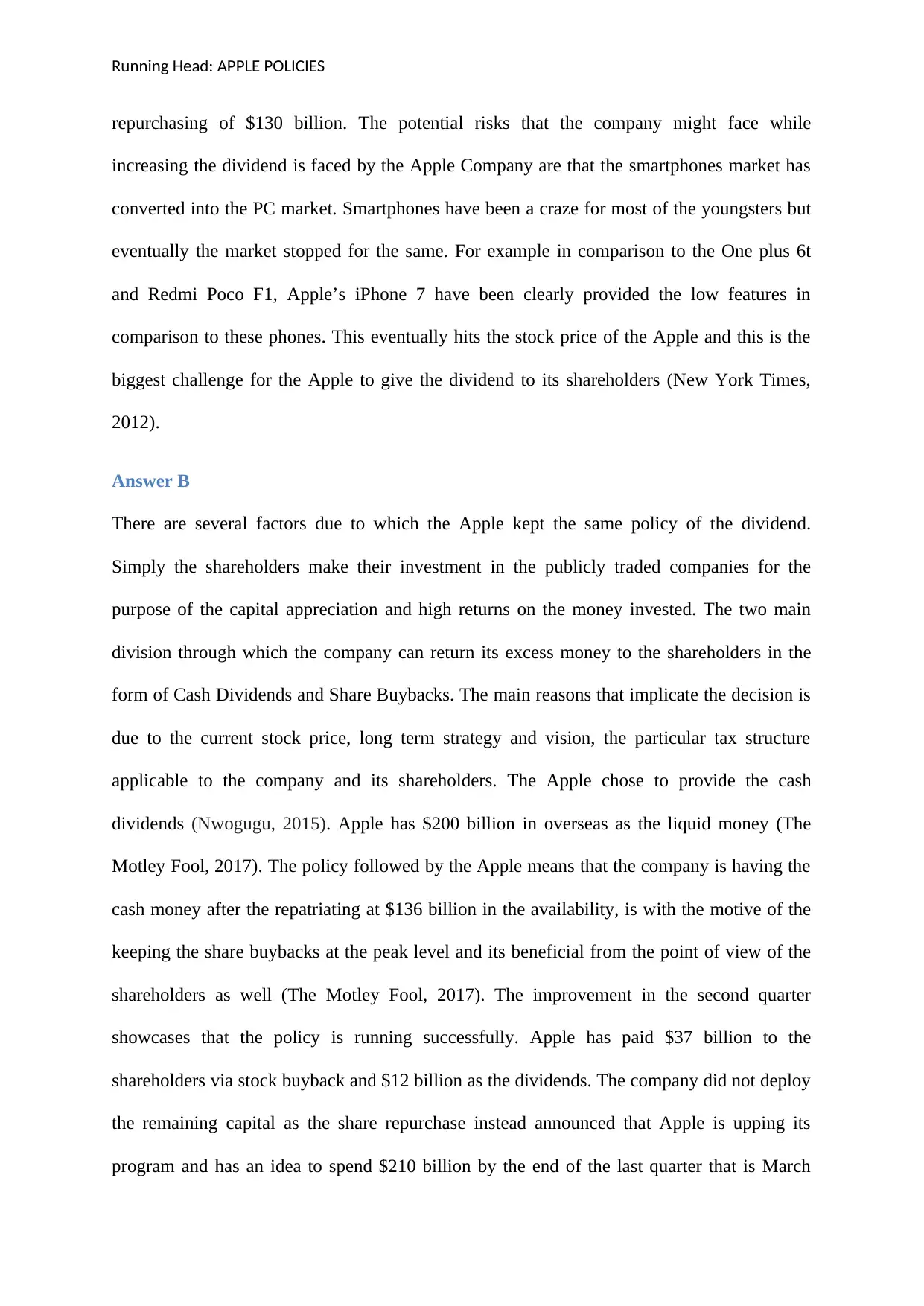
Running Head: APPLE POLICIES
repurchasing of $130 billion. The potential risks that the company might face while
increasing the dividend is faced by the Apple Company are that the smartphones market has
converted into the PC market. Smartphones have been a craze for most of the youngsters but
eventually the market stopped for the same. For example in comparison to the One plus 6t
and Redmi Poco F1, Apple’s iPhone 7 have been clearly provided the low features in
comparison to these phones. This eventually hits the stock price of the Apple and this is the
biggest challenge for the Apple to give the dividend to its shareholders (New York Times,
2012).
Answer B
There are several factors due to which the Apple kept the same policy of the dividend.
Simply the shareholders make their investment in the publicly traded companies for the
purpose of the capital appreciation and high returns on the money invested. The two main
division through which the company can return its excess money to the shareholders in the
form of Cash Dividends and Share Buybacks. The main reasons that implicate the decision is
due to the current stock price, long term strategy and vision, the particular tax structure
applicable to the company and its shareholders. The Apple chose to provide the cash
dividends (Nwogugu, 2015). Apple has $200 billion in overseas as the liquid money (The
Motley Fool, 2017). The policy followed by the Apple means that the company is having the
cash money after the repatriating at $136 billion in the availability, is with the motive of the
keeping the share buybacks at the peak level and its beneficial from the point of view of the
shareholders as well (The Motley Fool, 2017). The improvement in the second quarter
showcases that the policy is running successfully. Apple has paid $37 billion to the
shareholders via stock buyback and $12 billion as the dividends. The company did not deploy
the remaining capital as the share repurchase instead announced that Apple is upping its
program and has an idea to spend $210 billion by the end of the last quarter that is March
repurchasing of $130 billion. The potential risks that the company might face while
increasing the dividend is faced by the Apple Company are that the smartphones market has
converted into the PC market. Smartphones have been a craze for most of the youngsters but
eventually the market stopped for the same. For example in comparison to the One plus 6t
and Redmi Poco F1, Apple’s iPhone 7 have been clearly provided the low features in
comparison to these phones. This eventually hits the stock price of the Apple and this is the
biggest challenge for the Apple to give the dividend to its shareholders (New York Times,
2012).
Answer B
There are several factors due to which the Apple kept the same policy of the dividend.
Simply the shareholders make their investment in the publicly traded companies for the
purpose of the capital appreciation and high returns on the money invested. The two main
division through which the company can return its excess money to the shareholders in the
form of Cash Dividends and Share Buybacks. The main reasons that implicate the decision is
due to the current stock price, long term strategy and vision, the particular tax structure
applicable to the company and its shareholders. The Apple chose to provide the cash
dividends (Nwogugu, 2015). Apple has $200 billion in overseas as the liquid money (The
Motley Fool, 2017). The policy followed by the Apple means that the company is having the
cash money after the repatriating at $136 billion in the availability, is with the motive of the
keeping the share buybacks at the peak level and its beneficial from the point of view of the
shareholders as well (The Motley Fool, 2017). The improvement in the second quarter
showcases that the policy is running successfully. Apple has paid $37 billion to the
shareholders via stock buyback and $12 billion as the dividends. The company did not deploy
the remaining capital as the share repurchase instead announced that Apple is upping its
program and has an idea to spend $210 billion by the end of the last quarter that is March
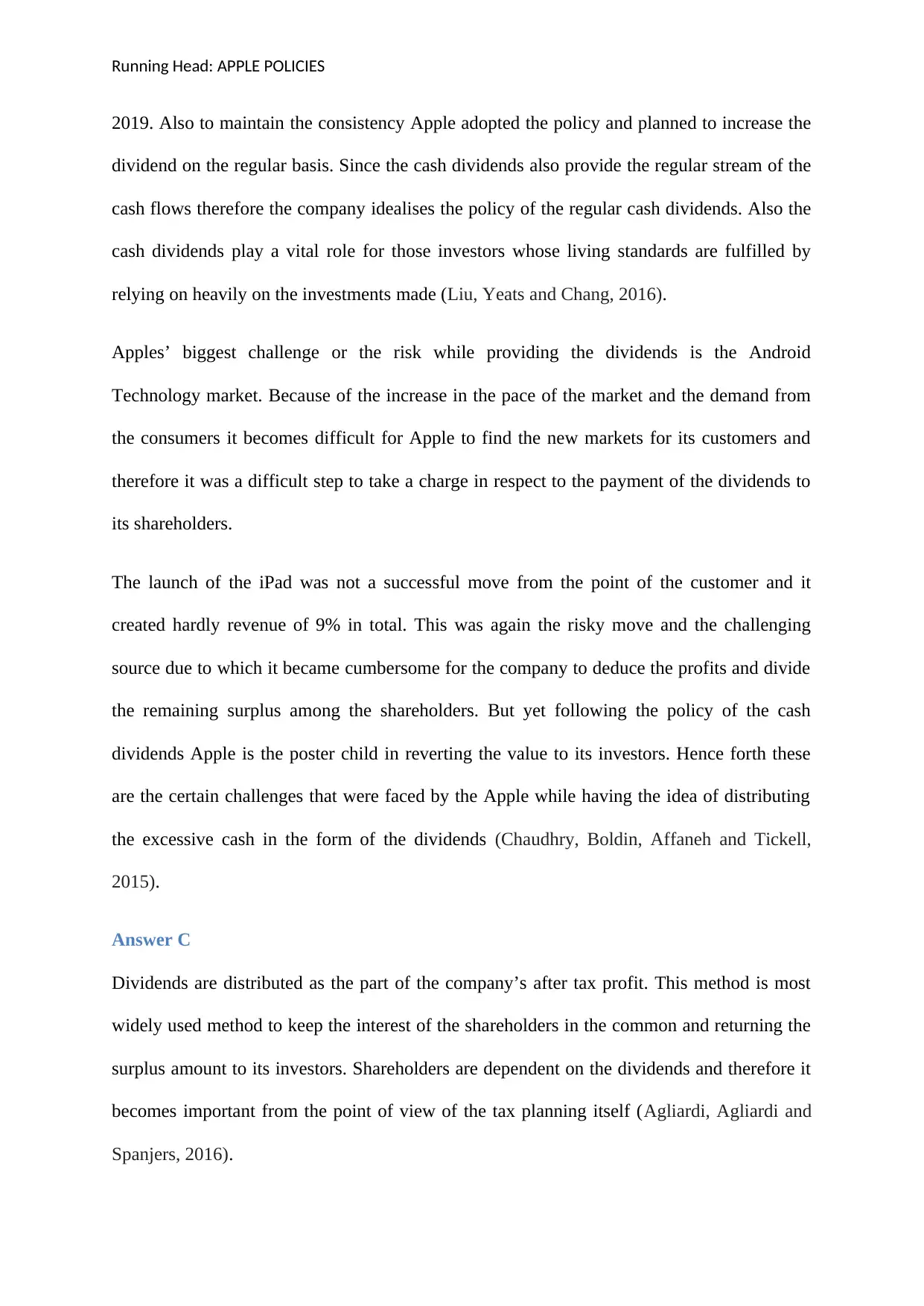
Running Head: APPLE POLICIES
2019. Also to maintain the consistency Apple adopted the policy and planned to increase the
dividend on the regular basis. Since the cash dividends also provide the regular stream of the
cash flows therefore the company idealises the policy of the regular cash dividends. Also the
cash dividends play a vital role for those investors whose living standards are fulfilled by
relying on heavily on the investments made (Liu, Yeats and Chang, 2016).
Apples’ biggest challenge or the risk while providing the dividends is the Android
Technology market. Because of the increase in the pace of the market and the demand from
the consumers it becomes difficult for Apple to find the new markets for its customers and
therefore it was a difficult step to take a charge in respect to the payment of the dividends to
its shareholders.
The launch of the iPad was not a successful move from the point of the customer and it
created hardly revenue of 9% in total. This was again the risky move and the challenging
source due to which it became cumbersome for the company to deduce the profits and divide
the remaining surplus among the shareholders. But yet following the policy of the cash
dividends Apple is the poster child in reverting the value to its investors. Hence forth these
are the certain challenges that were faced by the Apple while having the idea of distributing
the excessive cash in the form of the dividends (Chaudhry, Boldin, Affaneh and Tickell,
2015).
Answer C
Dividends are distributed as the part of the company’s after tax profit. This method is most
widely used method to keep the interest of the shareholders in the common and returning the
surplus amount to its investors. Shareholders are dependent on the dividends and therefore it
becomes important from the point of view of the tax planning itself (Agliardi, Agliardi and
Spanjers, 2016).
2019. Also to maintain the consistency Apple adopted the policy and planned to increase the
dividend on the regular basis. Since the cash dividends also provide the regular stream of the
cash flows therefore the company idealises the policy of the regular cash dividends. Also the
cash dividends play a vital role for those investors whose living standards are fulfilled by
relying on heavily on the investments made (Liu, Yeats and Chang, 2016).
Apples’ biggest challenge or the risk while providing the dividends is the Android
Technology market. Because of the increase in the pace of the market and the demand from
the consumers it becomes difficult for Apple to find the new markets for its customers and
therefore it was a difficult step to take a charge in respect to the payment of the dividends to
its shareholders.
The launch of the iPad was not a successful move from the point of the customer and it
created hardly revenue of 9% in total. This was again the risky move and the challenging
source due to which it became cumbersome for the company to deduce the profits and divide
the remaining surplus among the shareholders. But yet following the policy of the cash
dividends Apple is the poster child in reverting the value to its investors. Hence forth these
are the certain challenges that were faced by the Apple while having the idea of distributing
the excessive cash in the form of the dividends (Chaudhry, Boldin, Affaneh and Tickell,
2015).
Answer C
Dividends are distributed as the part of the company’s after tax profit. This method is most
widely used method to keep the interest of the shareholders in the common and returning the
surplus amount to its investors. Shareholders are dependent on the dividends and therefore it
becomes important from the point of view of the tax planning itself (Agliardi, Agliardi and
Spanjers, 2016).
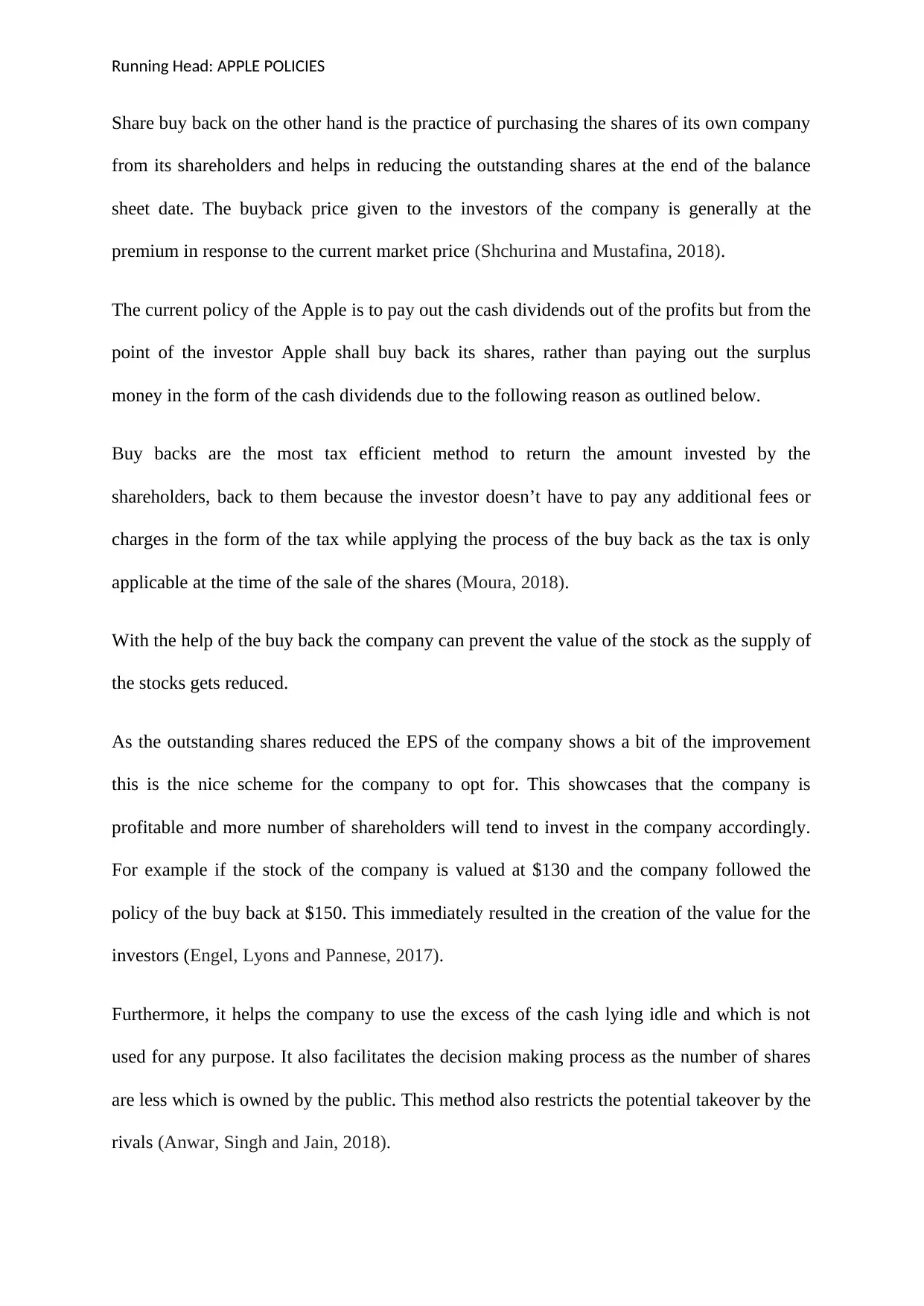
Running Head: APPLE POLICIES
Share buy back on the other hand is the practice of purchasing the shares of its own company
from its shareholders and helps in reducing the outstanding shares at the end of the balance
sheet date. The buyback price given to the investors of the company is generally at the
premium in response to the current market price (Shchurina and Mustafina, 2018).
The current policy of the Apple is to pay out the cash dividends out of the profits but from the
point of the investor Apple shall buy back its shares, rather than paying out the surplus
money in the form of the cash dividends due to the following reason as outlined below.
Buy backs are the most tax efficient method to return the amount invested by the
shareholders, back to them because the investor doesn’t have to pay any additional fees or
charges in the form of the tax while applying the process of the buy back as the tax is only
applicable at the time of the sale of the shares (Moura, 2018).
With the help of the buy back the company can prevent the value of the stock as the supply of
the stocks gets reduced.
As the outstanding shares reduced the EPS of the company shows a bit of the improvement
this is the nice scheme for the company to opt for. This showcases that the company is
profitable and more number of shareholders will tend to invest in the company accordingly.
For example if the stock of the company is valued at $130 and the company followed the
policy of the buy back at $150. This immediately resulted in the creation of the value for the
investors (Engel, Lyons and Pannese, 2017).
Furthermore, it helps the company to use the excess of the cash lying idle and which is not
used for any purpose. It also facilitates the decision making process as the number of shares
are less which is owned by the public. This method also restricts the potential takeover by the
rivals (Anwar, Singh and Jain, 2018).
Share buy back on the other hand is the practice of purchasing the shares of its own company
from its shareholders and helps in reducing the outstanding shares at the end of the balance
sheet date. The buyback price given to the investors of the company is generally at the
premium in response to the current market price (Shchurina and Mustafina, 2018).
The current policy of the Apple is to pay out the cash dividends out of the profits but from the
point of the investor Apple shall buy back its shares, rather than paying out the surplus
money in the form of the cash dividends due to the following reason as outlined below.
Buy backs are the most tax efficient method to return the amount invested by the
shareholders, back to them because the investor doesn’t have to pay any additional fees or
charges in the form of the tax while applying the process of the buy back as the tax is only
applicable at the time of the sale of the shares (Moura, 2018).
With the help of the buy back the company can prevent the value of the stock as the supply of
the stocks gets reduced.
As the outstanding shares reduced the EPS of the company shows a bit of the improvement
this is the nice scheme for the company to opt for. This showcases that the company is
profitable and more number of shareholders will tend to invest in the company accordingly.
For example if the stock of the company is valued at $130 and the company followed the
policy of the buy back at $150. This immediately resulted in the creation of the value for the
investors (Engel, Lyons and Pannese, 2017).
Furthermore, it helps the company to use the excess of the cash lying idle and which is not
used for any purpose. It also facilitates the decision making process as the number of shares
are less which is owned by the public. This method also restricts the potential takeover by the
rivals (Anwar, Singh and Jain, 2018).
Paraphrase This Document
Need a fresh take? Get an instant paraphrase of this document with our AI Paraphraser
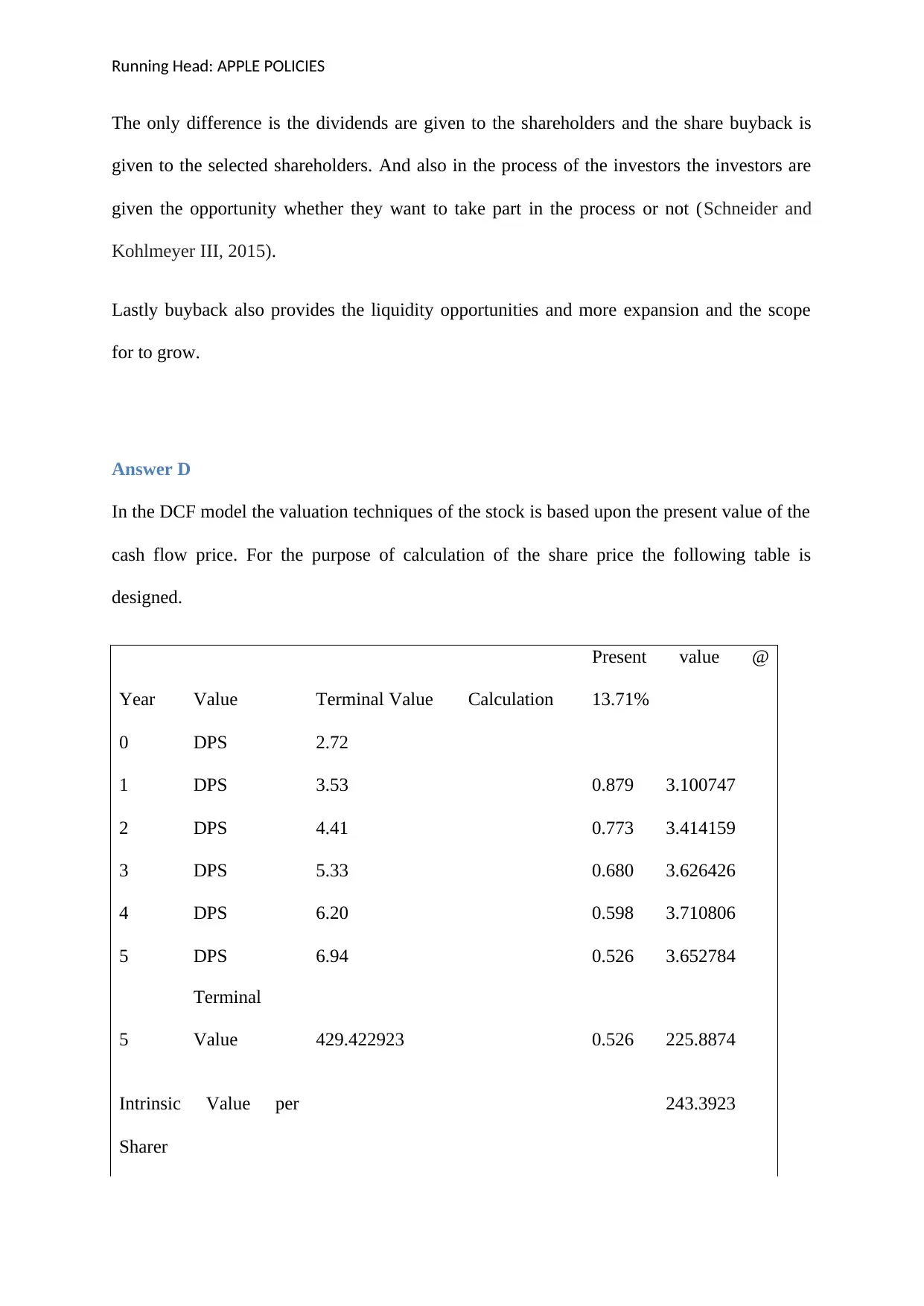
Running Head: APPLE POLICIES
The only difference is the dividends are given to the shareholders and the share buyback is
given to the selected shareholders. And also in the process of the investors the investors are
given the opportunity whether they want to take part in the process or not (Schneider and
Kohlmeyer III, 2015).
Lastly buyback also provides the liquidity opportunities and more expansion and the scope
for to grow.
Answer D
In the DCF model the valuation techniques of the stock is based upon the present value of the
cash flow price. For the purpose of calculation of the share price the following table is
designed.
Year Value Terminal Value Calculation
Present value @
13.71%
0 DPS 2.72
1 DPS 3.53 0.879 3.100747
2 DPS 4.41 0.773 3.414159
3 DPS 5.33 0.680 3.626426
4 DPS 6.20 0.598 3.710806
5 DPS 6.94 0.526 3.652784
5
Terminal
Value 429.422923 0.526 225.8874
Intrinsic Value per
Sharer
243.3923
The only difference is the dividends are given to the shareholders and the share buyback is
given to the selected shareholders. And also in the process of the investors the investors are
given the opportunity whether they want to take part in the process or not (Schneider and
Kohlmeyer III, 2015).
Lastly buyback also provides the liquidity opportunities and more expansion and the scope
for to grow.
Answer D
In the DCF model the valuation techniques of the stock is based upon the present value of the
cash flow price. For the purpose of calculation of the share price the following table is
designed.
Year Value Terminal Value Calculation
Present value @
13.71%
0 DPS 2.72
1 DPS 3.53 0.879 3.100747
2 DPS 4.41 0.773 3.414159
3 DPS 5.33 0.680 3.626426
4 DPS 6.20 0.598 3.710806
5 DPS 6.94 0.526 3.652784
5
Terminal
Value 429.422923 0.526 225.8874
Intrinsic Value per
Sharer
243.3923
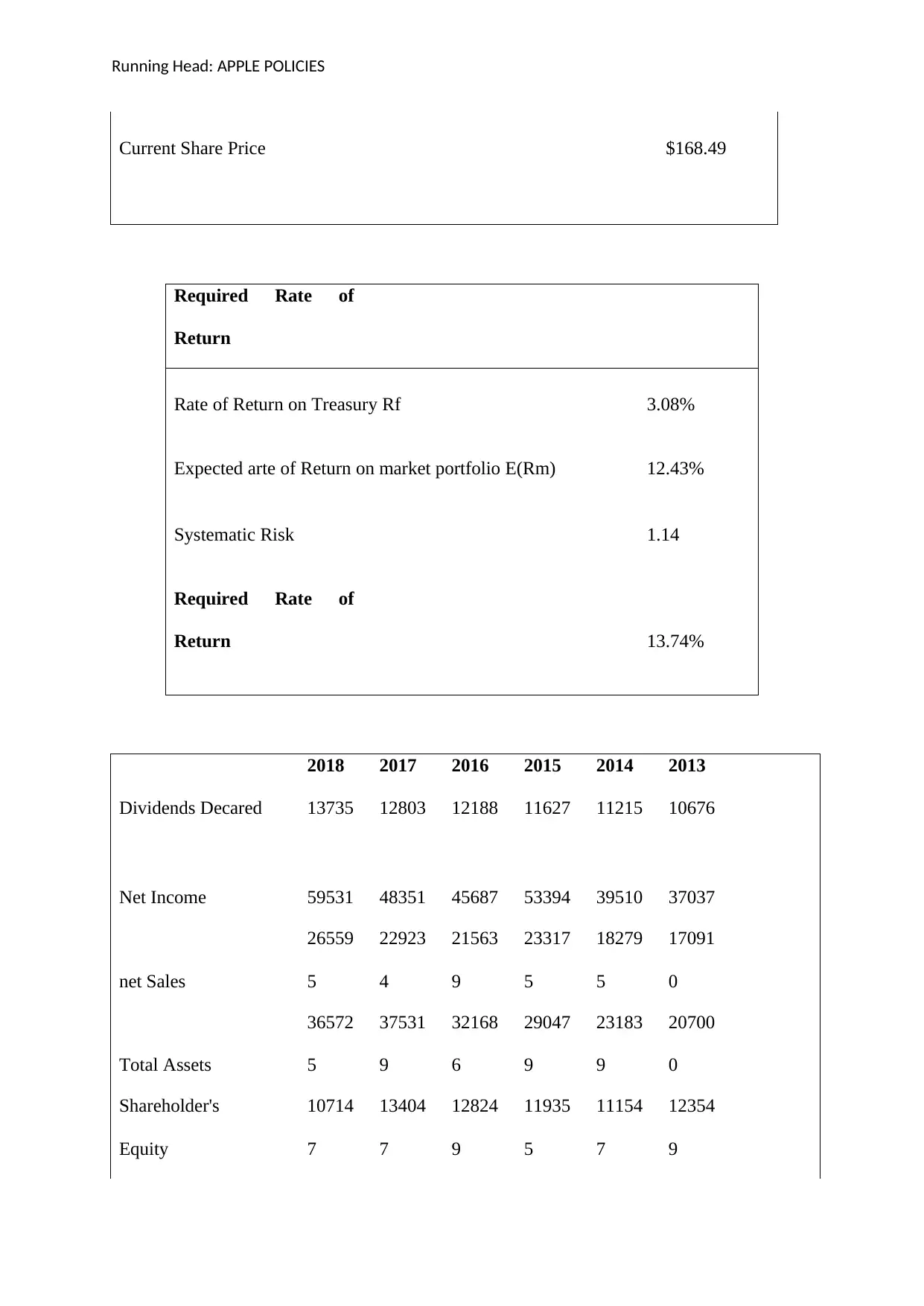
Running Head: APPLE POLICIES
Current Share Price $168.49
Required Rate of
Return
Rate of Return on Treasury Rf 3.08%
Expected arte of Return on market portfolio E(Rm) 12.43%
Systematic Risk 1.14
Required Rate of
Return 13.74%
2018 2017 2016 2015 2014 2013
Dividends Decared 13735 12803 12188 11627 11215 10676
Net Income 59531 48351 45687 53394 39510 37037
net Sales
26559
5
22923
4
21563
9
23317
5
18279
5
17091
0
Total Assets
36572
5
37531
9
32168
6
29047
9
23183
9
20700
0
Shareholder's
Equity
10714
7
13404
7
12824
9
11935
5
11154
7
12354
9
Current Share Price $168.49
Required Rate of
Return
Rate of Return on Treasury Rf 3.08%
Expected arte of Return on market portfolio E(Rm) 12.43%
Systematic Risk 1.14
Required Rate of
Return 13.74%
2018 2017 2016 2015 2014 2013
Dividends Decared 13735 12803 12188 11627 11215 10676
Net Income 59531 48351 45687 53394 39510 37037
net Sales
26559
5
22923
4
21563
9
23317
5
18279
5
17091
0
Total Assets
36572
5
37531
9
32168
6
29047
9
23183
9
20700
0
Shareholder's
Equity
10714
7
13404
7
12824
9
11935
5
11154
7
12354
9
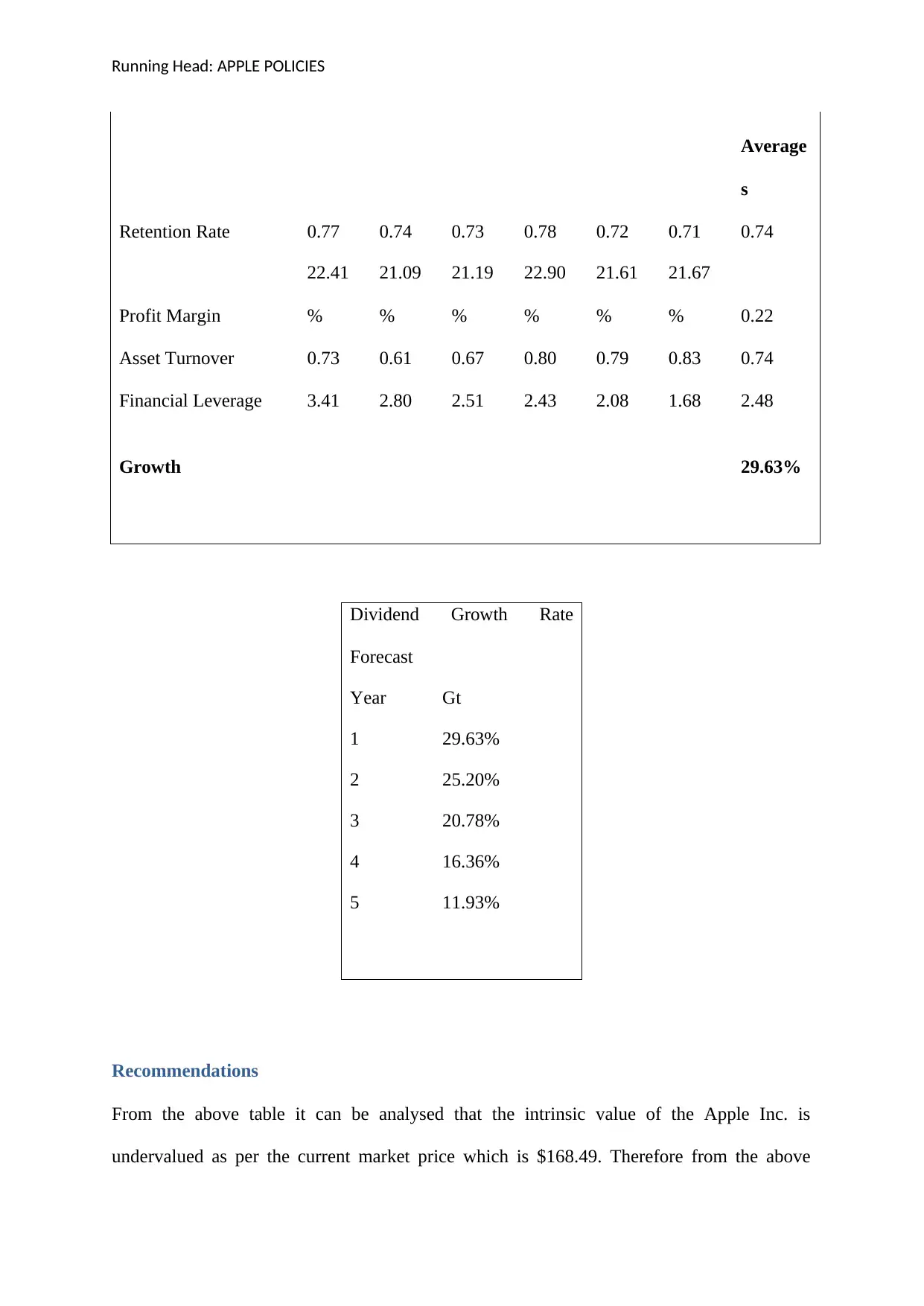
Running Head: APPLE POLICIES
Average
s
Retention Rate 0.77 0.74 0.73 0.78 0.72 0.71 0.74
Profit Margin
22.41
%
21.09
%
21.19
%
22.90
%
21.61
%
21.67
% 0.22
Asset Turnover 0.73 0.61 0.67 0.80 0.79 0.83 0.74
Financial Leverage 3.41 2.80 2.51 2.43 2.08 1.68 2.48
Growth 29.63%
Dividend Growth Rate
Forecast
Year Gt
1 29.63%
2 25.20%
3 20.78%
4 16.36%
5 11.93%
Recommendations
From the above table it can be analysed that the intrinsic value of the Apple Inc. is
undervalued as per the current market price which is $168.49. Therefore from the above
Average
s
Retention Rate 0.77 0.74 0.73 0.78 0.72 0.71 0.74
Profit Margin
22.41
%
21.09
%
21.19
%
22.90
%
21.61
%
21.67
% 0.22
Asset Turnover 0.73 0.61 0.67 0.80 0.79 0.83 0.74
Financial Leverage 3.41 2.80 2.51 2.43 2.08 1.68 2.48
Growth 29.63%
Dividend Growth Rate
Forecast
Year Gt
1 29.63%
2 25.20%
3 20.78%
4 16.36%
5 11.93%
Recommendations
From the above table it can be analysed that the intrinsic value of the Apple Inc. is
undervalued as per the current market price which is $168.49. Therefore from the above
Secure Best Marks with AI Grader
Need help grading? Try our AI Grader for instant feedback on your assignments.
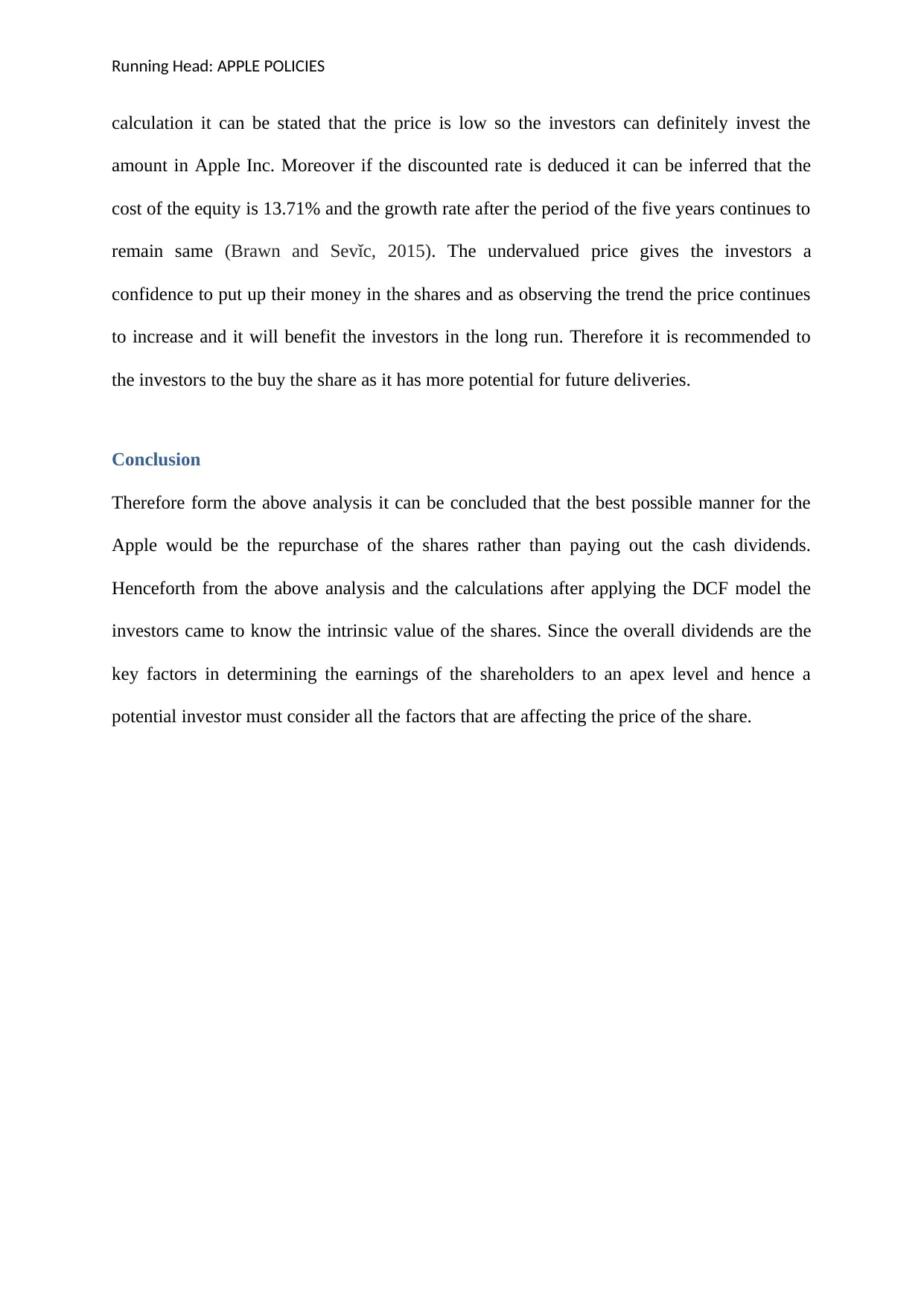
Running Head: APPLE POLICIES
calculation it can be stated that the price is low so the investors can definitely invest the
amount in Apple Inc. Moreover if the discounted rate is deduced it can be inferred that the
cost of the equity is 13.71% and the growth rate after the period of the five years continues to
remain same (Brawn and Sevǐc, 2015). The undervalued price gives the investors a
confidence to put up their money in the shares and as observing the trend the price continues
to increase and it will benefit the investors in the long run. Therefore it is recommended to
the investors to the buy the share as it has more potential for future deliveries.
Conclusion
Therefore form the above analysis it can be concluded that the best possible manner for the
Apple would be the repurchase of the shares rather than paying out the cash dividends.
Henceforth from the above analysis and the calculations after applying the DCF model the
investors came to know the intrinsic value of the shares. Since the overall dividends are the
key factors in determining the earnings of the shareholders to an apex level and hence a
potential investor must consider all the factors that are affecting the price of the share.
calculation it can be stated that the price is low so the investors can definitely invest the
amount in Apple Inc. Moreover if the discounted rate is deduced it can be inferred that the
cost of the equity is 13.71% and the growth rate after the period of the five years continues to
remain same (Brawn and Sevǐc, 2015). The undervalued price gives the investors a
confidence to put up their money in the shares and as observing the trend the price continues
to increase and it will benefit the investors in the long run. Therefore it is recommended to
the investors to the buy the share as it has more potential for future deliveries.
Conclusion
Therefore form the above analysis it can be concluded that the best possible manner for the
Apple would be the repurchase of the shares rather than paying out the cash dividends.
Henceforth from the above analysis and the calculations after applying the DCF model the
investors came to know the intrinsic value of the shares. Since the overall dividends are the
key factors in determining the earnings of the shareholders to an apex level and hence a
potential investor must consider all the factors that are affecting the price of the share.
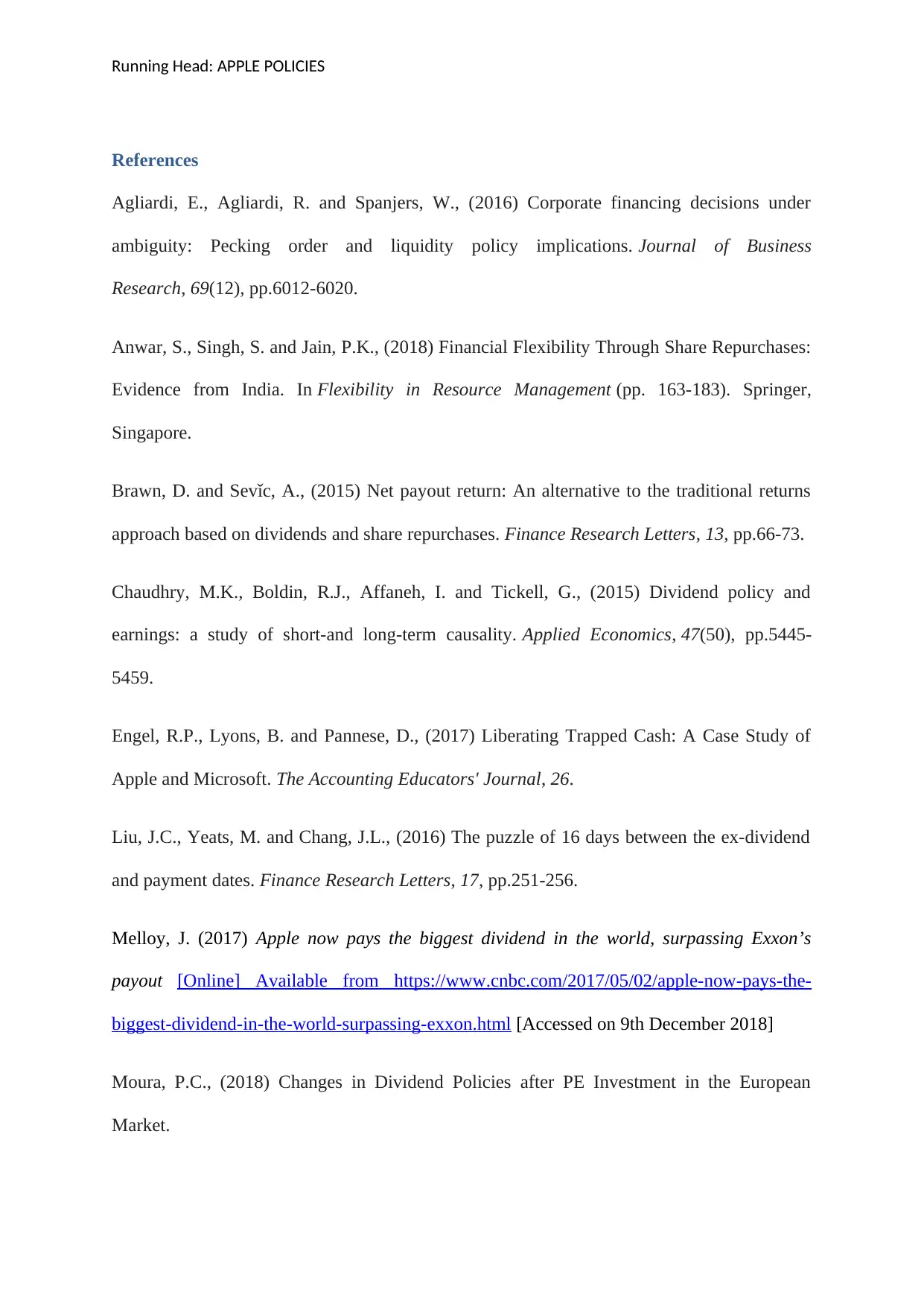
Running Head: APPLE POLICIES
References
Agliardi, E., Agliardi, R. and Spanjers, W., (2016) Corporate financing decisions under
ambiguity: Pecking order and liquidity policy implications. Journal of Business
Research, 69(12), pp.6012-6020.
Anwar, S., Singh, S. and Jain, P.K., (2018) Financial Flexibility Through Share Repurchases:
Evidence from India. In Flexibility in Resource Management (pp. 163-183). Springer,
Singapore.
Brawn, D. and Sevǐc, A., (2015) Net payout return: An alternative to the traditional returns
approach based on dividends and share repurchases. Finance Research Letters, 13, pp.66-73.
Chaudhry, M.K., Boldin, R.J., Affaneh, I. and Tickell, G., (2015) Dividend policy and
earnings: a study of short-and long-term causality. Applied Economics, 47(50), pp.5445-
5459.
Engel, R.P., Lyons, B. and Pannese, D., (2017) Liberating Trapped Cash: A Case Study of
Apple and Microsoft. The Accounting Educators' Journal, 26.
Liu, J.C., Yeats, M. and Chang, J.L., (2016) The puzzle of 16 days between the ex-dividend
and payment dates. Finance Research Letters, 17, pp.251-256.
Melloy, J. (2017) Apple now pays the biggest dividend in the world, surpassing Exxon’s
payout [Online] Available from https://www.cnbc.com/2017/05/02/apple-now-pays-the-
biggest-dividend-in-the-world-surpassing-exxon.html [Accessed on 9th December 2018]
Moura, P.C., (2018) Changes in Dividend Policies after PE Investment in the European
Market.
References
Agliardi, E., Agliardi, R. and Spanjers, W., (2016) Corporate financing decisions under
ambiguity: Pecking order and liquidity policy implications. Journal of Business
Research, 69(12), pp.6012-6020.
Anwar, S., Singh, S. and Jain, P.K., (2018) Financial Flexibility Through Share Repurchases:
Evidence from India. In Flexibility in Resource Management (pp. 163-183). Springer,
Singapore.
Brawn, D. and Sevǐc, A., (2015) Net payout return: An alternative to the traditional returns
approach based on dividends and share repurchases. Finance Research Letters, 13, pp.66-73.
Chaudhry, M.K., Boldin, R.J., Affaneh, I. and Tickell, G., (2015) Dividend policy and
earnings: a study of short-and long-term causality. Applied Economics, 47(50), pp.5445-
5459.
Engel, R.P., Lyons, B. and Pannese, D., (2017) Liberating Trapped Cash: A Case Study of
Apple and Microsoft. The Accounting Educators' Journal, 26.
Liu, J.C., Yeats, M. and Chang, J.L., (2016) The puzzle of 16 days between the ex-dividend
and payment dates. Finance Research Letters, 17, pp.251-256.
Melloy, J. (2017) Apple now pays the biggest dividend in the world, surpassing Exxon’s
payout [Online] Available from https://www.cnbc.com/2017/05/02/apple-now-pays-the-
biggest-dividend-in-the-world-surpassing-exxon.html [Accessed on 9th December 2018]
Moura, P.C., (2018) Changes in Dividend Policies after PE Investment in the European
Market.
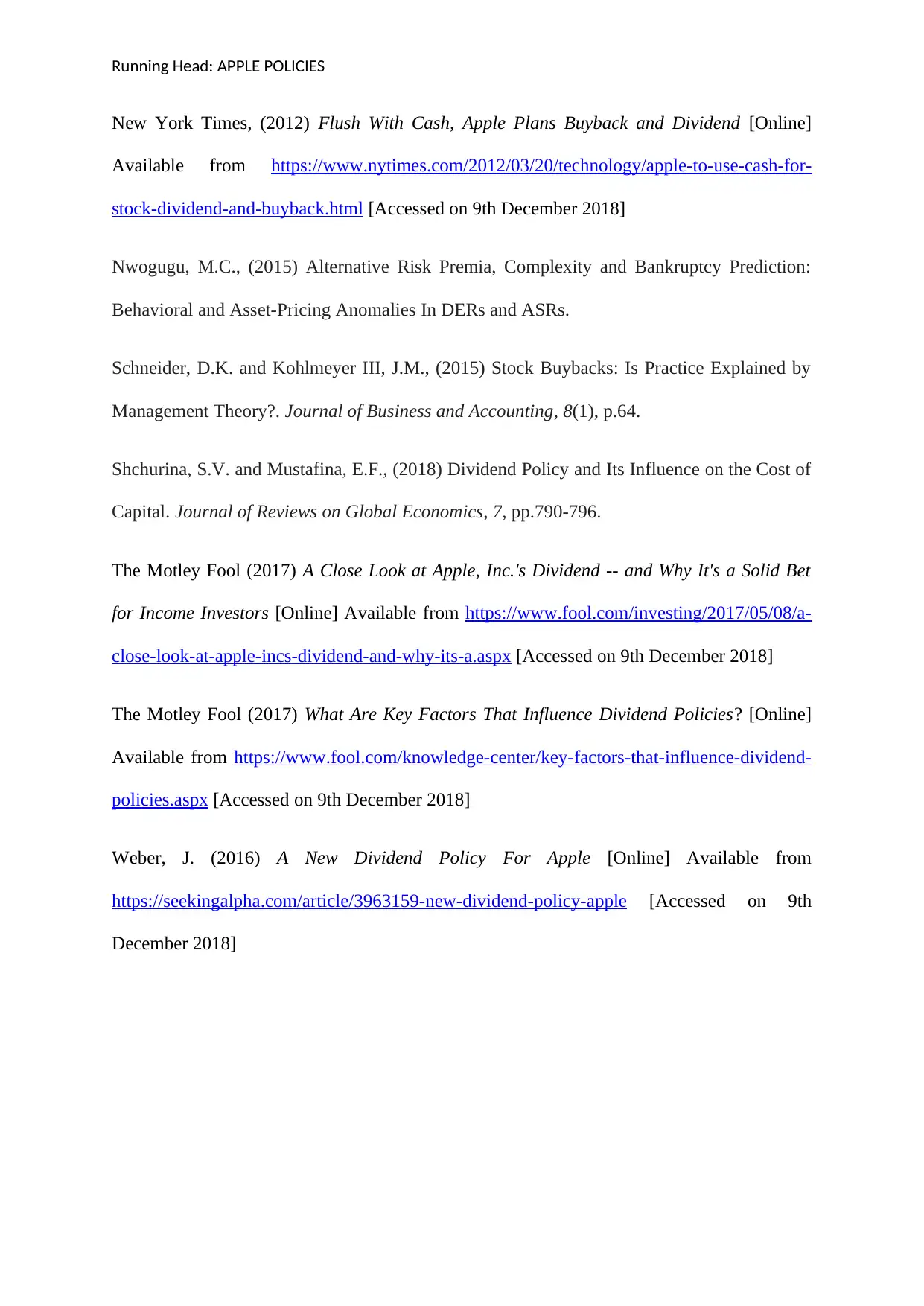
Running Head: APPLE POLICIES
New York Times, (2012) Flush With Cash, Apple Plans Buyback and Dividend [Online]
Available from https://www.nytimes.com/2012/03/20/technology/apple-to-use-cash-for-
stock-dividend-and-buyback.html [Accessed on 9th December 2018]
Nwogugu, M.C., (2015) Alternative Risk Premia, Complexity and Bankruptcy Prediction:
Behavioral and Asset-Pricing Anomalies In DERs and ASRs.
Schneider, D.K. and Kohlmeyer III, J.M., (2015) Stock Buybacks: Is Practice Explained by
Management Theory?. Journal of Business and Accounting, 8(1), p.64.
Shchurina, S.V. and Mustafina, E.F., (2018) Dividend Policy and Its Influence on the Cost of
Capital. Journal of Reviews on Global Economics, 7, pp.790-796.
The Motley Fool (2017) A Close Look at Apple, Inc.'s Dividend -- and Why It's a Solid Bet
for Income Investors [Online] Available from https://www.fool.com/investing/2017/05/08/a-
close-look-at-apple-incs-dividend-and-why-its-a.aspx [Accessed on 9th December 2018]
The Motley Fool (2017) What Are Key Factors That Influence Dividend Policies? [Online]
Available from https://www.fool.com/knowledge-center/key-factors-that-influence-dividend-
policies.aspx [Accessed on 9th December 2018]
Weber, J. (2016) A New Dividend Policy For Apple [Online] Available from
https://seekingalpha.com/article/3963159-new-dividend-policy-apple [Accessed on 9th
December 2018]
New York Times, (2012) Flush With Cash, Apple Plans Buyback and Dividend [Online]
Available from https://www.nytimes.com/2012/03/20/technology/apple-to-use-cash-for-
stock-dividend-and-buyback.html [Accessed on 9th December 2018]
Nwogugu, M.C., (2015) Alternative Risk Premia, Complexity and Bankruptcy Prediction:
Behavioral and Asset-Pricing Anomalies In DERs and ASRs.
Schneider, D.K. and Kohlmeyer III, J.M., (2015) Stock Buybacks: Is Practice Explained by
Management Theory?. Journal of Business and Accounting, 8(1), p.64.
Shchurina, S.V. and Mustafina, E.F., (2018) Dividend Policy and Its Influence on the Cost of
Capital. Journal of Reviews on Global Economics, 7, pp.790-796.
The Motley Fool (2017) A Close Look at Apple, Inc.'s Dividend -- and Why It's a Solid Bet
for Income Investors [Online] Available from https://www.fool.com/investing/2017/05/08/a-
close-look-at-apple-incs-dividend-and-why-its-a.aspx [Accessed on 9th December 2018]
The Motley Fool (2017) What Are Key Factors That Influence Dividend Policies? [Online]
Available from https://www.fool.com/knowledge-center/key-factors-that-influence-dividend-
policies.aspx [Accessed on 9th December 2018]
Weber, J. (2016) A New Dividend Policy For Apple [Online] Available from
https://seekingalpha.com/article/3963159-new-dividend-policy-apple [Accessed on 9th
December 2018]
1 out of 13
Related Documents
Your All-in-One AI-Powered Toolkit for Academic Success.
+13062052269
info@desklib.com
Available 24*7 on WhatsApp / Email
![[object Object]](/_next/static/media/star-bottom.7253800d.svg)
Unlock your academic potential
© 2024 | Zucol Services PVT LTD | All rights reserved.





